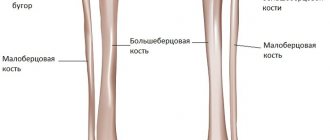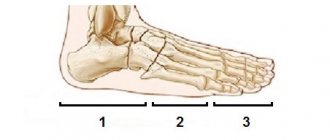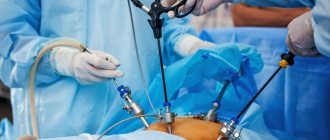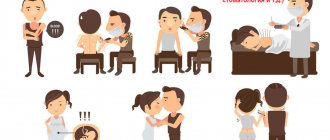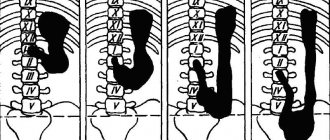Published: 10/05/2021 13:40:00 Updated: 10/05/2021
Appendicitis is an acute inflammation of the cecum, affecting its vermiform appendix (appendix). This anatomical organ is not a rudiment, as previously thought. It has an immune function and is involved in the formation of intestinal microbiota, so the recent “fashion” for preventive appendectomy had no real clinical basis. However, if the appendix is inflamed, it must be removed surgically.
The disease is infectious in origin, develops quickly and requires emergency surgical care. Acute appendicitis is in the group of 7 nosological forms, combined into the “Acute abdomen” symptom complex, occupying a share of 27.7% in its structure [1]. The incidence of acute appendicitis in Europe is 12 cases per 100 people, more than 220,000 operations are performed annually in Russia, and the mortality rate is 0.13% [2].
Appendicitis can happen to a person of any age and gender, previously predominantly in those aged 10 to 19 years, but in recent years the incidence of appendicitis has increased in the age group from 30 to 69 years [1].
Acute appendicitis can be catarrhal (simple, without complications), gangrenous, phlegmonous, with empyema of the appendix, primary or secondary.
Symptoms of appendicitis
Classic signs of acute appendicitis:
- vomiting and nausea, mainly in the first hours of illness;
- stomach ache;
- dry mouth, coated tongue;
- lack of appetite;
- adopting the fetal position (curling up on the sore side);
- lag of the right side of the abdomen when breathing;
- pain in the right lower abdomen when lifting a straight leg up from a position on the left side;
- pain when pressing between the navel and the ilium;
- pain when releasing the palm after pressing on the abdomen.
The main symptom of appendicitis is pain in the right lower abdomen, suddenly appearing, aching, constant, at first of uncertain localization, but then concentrated near the navel on the right.
Which side of appendicitis gives pain depends on the anatomical features of the location of the appendix. This could be the following localization:
- down to the right of the navel;
- right hypochondrium;
- closer to the midline to the right of the navel;
- in the lower right part of the abdomen, closer to the bladder;
- sometimes the pain radiates to the right hip joint and right thigh;
- Sometimes with appendicitis it hurts to the left of the navel or in the stomach area.
With appendicitis in pregnant women in the later stages, the pain is localized in the right side or right hypochondrium, since the pregnant uterus displaces all organs.
The greatest problem is represented by atypical forms of appendicitis. About a third of cases occur without traditional signs of appendicitis, masquerading as other diseases, which is especially important for women of fertile age. Urinary disorders, gallbladder diseases, diarrhea, very high body temperature, and gynecological diseases may occur.
Complications of acute appendicitis:
- rupture of the appendix;
- appendicular infiltrate or abscess (suppuration of the appendix);
- retroperitoneal phlegmon (suppuration in the retroperitoneal space);
- peritonitis (inflammation of the peritoneum);
- pylephlebitis (inflammation of the veins of the cecum);
- sepsis (blood poisoning).
Children and elderly people with chronic diseases of the cardiovascular system, diabetes mellitus, and neoplasms die from appendicitis.
Lack of treatment also leads to death; appendicitis cannot go away on its own. Delayed presentation also increases the risk of death. In St. Petersburg, for example, only 67% of patients with appendicitis see a doctor on the first day [1].
Are your teeth to blame?
Experts do not agree on the exact causes of appendicitis. However, risk groups have been identified.
For example, people suffering from diseases such as chronic tonsillitis, pneumonia, persistent colds, diseases of the gastrointestinal tract, caries. As a result of these diseases, infections penetrate through the bloodstream into the appendix and provoke an inflammatory process there. So healthy teeth are the key to a healthy appendix.
There is also a stress theory. It is based on the fact that as a result of excitement in a person, a sharp narrowing of the blood vessels occurs and this leads to sudden bleeding of the appendix and the development of its inflammation.
But most often the occurrence of appendicitis is explained by blockage of the junction of the colon and the appendix, which often happens with constipation and chronic colitis.
Appendicitis in children
The highest incidence occurs between the ages of 9 and 12 years, and in general, acute appendicitis occurs in 3-6 out of 1000 children [3].
Appendicitis in children over 3 years of age occurs almost the same as in adults. Young patients are characterized by:
- long-term localization of pain in the epigastrium, then throughout all parts of the abdomen;
- constipation or repeated diarrhea;
- repeated vomiting;
- restlessness, crying, lack of appetite;
- fever up to 39 °C;
- slight bloating, constant tension in the muscles of the abdominal wall.
In children, especially in the first three years of life, inflammation develops faster and complications are more frequent.
Blind but dangerous
The appendix is a short and thin blind vermiform appendix 7-10 cm long, located at the end of the cecum (the initial part of the large intestine). Like any part of the intestine, the appendix produces intestinal juice, but so little that it does not play a special role in digestion. Therefore, for a long time it was considered a “mistake of nature” and was removed by the patient at the first opportunity. But recently, scientists discovered lymphoid cells in the caecum, the same as in human tonsils. And since these cells have the properties to protect the body from infections, the assumption was born that the appendix is part of the immune system.
However, the number of protective cells in it, as it turned out, is very insignificant and cannot have a strong effect on the immune system. So most experts are still confident that there is no benefit from the appendix, but the harm in case of its inflammation can be significant: acute appendicitis not diagnosed in time can cost not only health, but also life.
Diagnosis of appendicitis
- First of all, a consultation with a surgeon is required in the first hour of hospitalization. Special diagnostic scales are used (AAS, Alvarado, RIPASA).
- If you have appendicitis in women, you need to consult a gynecologist.
- For dysuria, consult a urologist.
- Ultrasound of the abdominal cavity.
- CT scan of the abdominal cavity (pregnant women with appendicitis undergo ultrasound or MRI instead of CT).
- Diagnostic laparoscopy is a minimally invasive intervention in which the abdominal cavity is examined through a small incision with a laparoscope. Having detected signs of appendicitis, they proceed to laparoscopic appendectomy.
Summary
So, appendicitis can be acute and chronic. Depending on the stages, it is divided into catarrhal, phlegmonous, gangrenous and complicated. There are also atypical forms, which are characterized by a left-sided, subhepatic, medial, pelvic and retrocecal location.
According to statistics, people die from appendicitis and this is often due to late seeking medical help. Unusual forms of inflammation can be similar to a variety of diseases, which can confuse even the most experienced doctor.
If unusual symptoms appear, call an ambulance. Without a doctor's prescription, do not take medications on your own and do not use thermal procedures, which can be a fatal mistake in case of appendicitis. Timely and competent measures are the key to your speedy recovery!
Tests for appendicitis
- General clinical blood test (shows signs of inflammation in the form of increased ESR, C-reactive protein, leukocytosis, neutrophilia).
- General urine test (for differential diagnosis).
- Determination of alpha-amylase in urine (including pancreatic) - this enzyme allows you to identify inflammation of the abdominal organs.
- Culture of abdominal exudate for sensitivity to antibiotics.
- Histological examination of the appendix.
The material for the last two studies is taken during the operation.
Prices
Price (rub.)In installments* (rub.)Consultation with a surgeon on the operation (SPECIAL)0—Online doctor’s opinion on the operation (SPECIAL)0—Appendectomy Cat. I. complexity 26000—Appendectomy Cat. II. difficulty 36000—* You can read more about the conditions here - Treatment on credit or in installments
The cost is preliminary. The exact cost of the operation can only be determined by a surgeon during a free consultation.
Treatment of appendicitis
In the vast majority of cases, acute appendicitis requires surgery.
Only with appendiceal infiltrate and sometimes during pregnancy do they begin with conservative therapy, that is, intravenous antibiotics (amoxiclav or cefotaxime with metronidazole, tigecycline, ertapenem) for 2 days. Before the operation, medication preparation is carried out (water and electrolyte disturbances are eliminated, antibiotic therapy is administered, intoxication and pain are relieved, and thrombosis is prevented).
Removal of appendicitis - appendectomy - is performed as an abdominal or laparoscopic operation.
The risk of blood clots increases with:
- heavy weight;
- over 50 years of age;
- oncological diseases;
- history of heart attack and stroke;
- varicose veins;
- SLE and erythremia;
- postpartum period;
- injuries;
- taking hormonal contraceptives.
The operation is performed under general anesthesia or conduction anesthesia.
In case of a complicated course, antibiotics are also prescribed in the postoperative period; in case of catarrhal appendicitis, this is not required. On the first day, only liquid pureed food is given. The patient is discharged from the hospital on the 3-4th day, and the sutures are removed on the 5-8th day.
Atypical forms
The atypicality is explained by the fact that the process can be located differently. If the organ is located near the bladder and rectum, the patient will experience severe diarrhea and a frequent urge to urinate.
Retrocecal location
Occurs in more than half of the cases. A close presentation of the organ near the right kidney is characteristic. As you know, the muscles of the lumbar region and the ureter are located nearby. This arrangement causes constant acute pain on the right or in the epigastric region.
When walking, the pain in the hip joint on the right becomes more pronounced. Sometimes the patient may even limp. Nausea and vomiting rarely appear in the retrocecal form; they are more characteristic of typical manifestations of appendicitis. Atypical location causes diarrhea. During the examination, the doctor will not see tension in the muscles of the anterior abdominal wall.
Recovery after appendectomy
With uncomplicated appendicitis, recovery occurs quickly; complications require longer hospitalization and a longer period of postoperative rehabilitation.
Factors contributing to early recovery: early diagnosis and timely surgery, absence of concomitant diseases, young age, absence of complications.
Risk factors: late hospitalization, obesity, elderly and senile age, peritonitis, sepsis, multiple concomitant diseases.
Within a month after removal of appendicitis you should:
- limit physical activity, especially stress on the abdominal muscles;
- follow a diet that excludes vegetables, fruits, essential oils, smoked meats, animal fats, fried, spicy foods, foods rich in purines and cholesterol (red meat, lard, jelly, strong broths, packaged soups, smoked meats, fatty fish, legumes, canned food) , raspberries, figs, grapes, eggs, cottage cheese, butter, margarine, fatty dairy products.
With the modern level of development of medicine, appendicitis is treatable, but much depends on timely access to a doctor and correct behavior after surgery.
Bibliography
- Barsukova, I.M. Acute appendicitis: history and modern organization of medical care// I.M. Barsukova, M.V. Gavshchuk, A.P. Krivov. - text: direct // Scientific notes of St. Petersburg State Medical University named after. I. P. Pavlova, 2021.- No. 3 – P. 43-49, DOI: 10.24884/1607-4181-2018-25-3-43-49.
- Clinical guidelines “Acute appendicitis in adults”, 2021, Developers: All-Russian public association “Russian Society of Surgeons”, All-Russian public organization “Russian Society of Endoscopic Surgeons”. - Text: electronic. - URL: (access date: 09/29/2021).
- Draft clinical guidelines “Acute appendicitis in children”, 2016. Developer: Russian Association of Pediatric Surgeons, -Text: electronic.- URL: (access date: 09.29.2021).
Author:
Pugonina Tatyana Alekseevna, Therapist
Signs of peritonitis
Since, in case of untimely provision of medical care to the patient, perforation of the appendix and penetration of its contents into the peritoneum, leading to peritonitis, may occur, you should be aware that with peritonitis, the general condition of the patient sharply worsens. The eyes become sunken, the facial features become sharp. The patient begins to show anxiety, the heart rate increases sharply to 120 beats per minute. The pain spreads throughout the abdomen.




